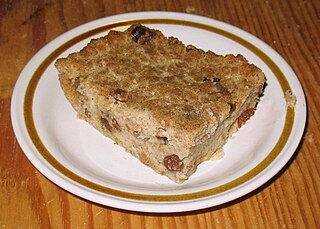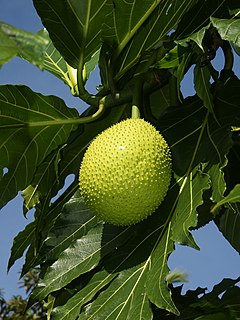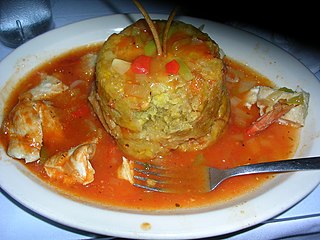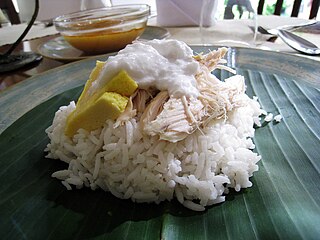Ladob is a dish eaten in the Seychelles which is eaten either as a savory dish or as a dessert.
It was originally a dish eaten in large amounts by the early arrivals to the island due to the ingredients being in plentiful supply. It is now a staple part of the diet, many eating the dish several times a week.
The dessert version usually consists of ripe plantain and sweet potatoes (but may also include cassava, breadfruit or even corossol) boiled with coconut milk, sugar, nutmeg and vanilla in the form of a pod until the fruit is soft and the sauce is creamy [1]
The savory version usually includes salted fish, cooked in a similar fashion to the dessert version, with plantain, cassava and breadfruit, but with salt used in place of sugar (and omitting vanilla).
Ladob can be served hot or cold.

Cooking bananas are banana cultivars in the genus Musa whose fruits are generally used in cooking. They may be eaten ripe or unripe and are generally starchy. Many cooking bananas are referred to as plantains or green bananas. In botanical usage, the term "plantain" is used only for true plantains, while other starchy cultivars used for cooking are called "cooking bananas". True plantains are cultivars belonging to the AAB Group, while cooking bananas are any cultivars belonging to AAB, AAA, ABB, or BBB groups. The currently accepted scientific name for all such cultivars in these groups is Musa × paradisiaca. Fe'i bananas from the Pacific Islands are often eaten roasted or boiled, and are thus informally referred to as "mountain plantains," but they do not belong to any of the species from which all modern banana cultivars are descended.

Bread pudding is a bread-based dessert popular in many countries' cuisines. It is made with stale bread and milk or cream, generally containing eggs, a form of fat such as oil, butter or suet and, depending on whether the pudding is sweet or savory, a variety of other ingredients. Sweet bread puddings may use sugar, syrup, honey, dried fruit, nuts, as well as spices such as cinnamon, nutmeg, mace, or vanilla. The bread is soaked in the liquids, mixed with the other ingredients, and baked.

Breadfruit is a species of flowering tree in the mulberry and jackfruit family (Moraceae) believed to be a domesticated descendant of Artocarpus camansi originating in New Guinea, the Maluku Islands, and the Philippines. It was initially spread to Oceania via the Austronesian expansion. It was further spread to other tropical regions of the world during the Colonial Era. British and French navigators introduced a few Polynesian seedless varieties to Caribbean islands during the late 18th century. Today it is grown in some 90 countries throughout South and Southeast Asia, the Pacific Ocean, the Caribbean, Central America and Africa. Its name is derived from the texture of the moderately ripe fruit when cooked, similar to freshly baked bread and having a potato-like flavor.

Costa Rican cuisine is known for being fairly mild, with high reliance on fruits and vegetables. Rice and black beans are a staple of most traditional Costa Rican meals, often served three times a day. Costa Rican fare is nutritionally well rounded, and nearly always cooked from scratch from fresh ingredients. Owing to the location of the country, tropical fruits and vegetables are readily available and included in the local cuisine.
Jamaican cuisine includes a mixture of cooking techniques, flavours and spices influenced by Amerindian, African, Irish, English, French, Portuguese, Spanish, Indian, Chinese and Middle Eastern people who have inhabited the island. It is also influenced by the crops introduced into the island from tropical Southeast Asia, many of which are now grown locally. A wide variety of seafood, tropical fruits and meats are available.

Trinidad and Tobago cuisine is the cuisine of the Caribbean island state of Trinidad and Tobago. It reflects a fusion of African, Creole, Indian-South Asian, Afghan, Chinese, Amerindian, Arab, European, and Latin American-Spanish-Portuguese cuisines.

Fufu is a dough-like food found in West African cuisine. In addition to Ghana, it is also found in Sierra Leone, Guinea, Liberia, Cote D'Ivoire, Benin, Togo, Nigeria, Cameroon, the Democratic Republic of Congo, the Central African Republic, the Republic of Congo, Angola and Gabon. It is often made in the traditional Ghanaian, Ivorian, Liberian, and Cuban method of separately mixing and pounding equal portions of boiled cassava with green plantain or cocoyam, or by mixing cassava/plantains or cocoyam flour with water and stirring it on a stove. The viscosity is then adjusted based on personal preference and eaten with broth-like soups. Some countries, particularly Nigeria, have a version of fufu made from fermented Cassava dough that is eaten with thick textured stews. Other flours, such as semolina, maize flour, or mashed plantains may take the place of cassava flour. Fufu is eaten with the fingers, and a small ball of it can be dipped into an accompanying soup or sauce.

Rice pudding is a dish made from rice mixed with water or milk and other ingredients such as cinnamon, vanilla and raisins.

Mofongo is a Puerto Rican dish with fried plantains as its main ingredient. Plantains are picked green and fried, then mashed with salt, garlic, broth, and olive oil in a wooden pilón. The goal is to produce a tight ball of mashed plantains that will absorb the attending condiments and have either pork cracklings (chicharrón) or bits of bacon inside. It is traditionally served with fried meat and chicken broth soup. Particular flavors result from variations that include vegetables, chicken, shrimp, beef, or octopus packed inside or around the plantain orb.

A buñuelo is a fried dough fritter found in Spain, Latin America, Israel, and other regions with a historical connection to Spaniards or Sephardic Jews, including Southwest Europe, the Balkans, Anatolia, and other parts of Asia and North Africa. Buñuelos are traditionally prepared at Christmas, Ramadan, and among Sephardic Jews at Hanukkah. It will usually have a filling or a topping. In Mexican cuisine, it is often served with a syrup made with piloncillo.
Dominican cuisine is made up of Spanish, indigenous Taíno, Middle-Eastern and African influences. Many Middle-Eastern dishes have been adopted into Dominican cuisine, such as the "Quipe" that comes from the Lebanese kibbeh.

Haitian cuisine consists of cooking traditions and practices from Haiti. It is a Creole cuisine, that originates from a blend of several culinary styles that populated the western portion of the island of Hispaniola, namely the African, French, indigenous Taíno, Spanish and Arab influence. Haitian cuisine is comparable to that of "criollo" cooking and similar to the rest of the Latin Caribbean, but differs in several ways from its regional counterparts.

A banana fritter is a fritter made by deep frying battered banana or plantain in hot oil. It is a common dish across Southeast Asia and the Indian subcontinent.

Coconut rice is a dish prepared by soaking white rice in coconut milk or cooking it with coconut flakes. As both the coconut and the rice-plant are commonly found in the tropics all-around the world, coconut rice too is found in many cultures throughout the world, spanning across the equator from the Indian subcontinent, Southeast Asia, South America, Central America, East Africa, West Africa, the Caribbean and Oceania.
Belizean cuisine is an amalgamation of all ethnicities in the nation of Belize and their respectively wide variety of foods. Breakfast often consists of sides of bread, flour tortillas, or fry jacks that are often homemade and eaten with various cheeses. All are often accompanied with refried beans, cheeses, and various forms of eggs, etc. Inclusive is also cereal along with milk, coffee, or tea.
A great variety of cassava-based dishes are consumed in the regions where cassava is cultivated, and they include many national or ethnic specialities.

Seychellois cuisine is the cuisine of the Republic of Seychelles, an archipelago country consisting of 115 islands. Fish plays a prominent part in country's cuisine because of its location in the Indian Ocean. The Seychelles's cuisine has been influenced by African, British, French, Spanish, Indian and Chinese cuisines.
Kabkab, also known as cassava cracker or cassava crisp, is a traditional Filipino disc-shaped wafer made from ground cassava. It originates from the southern Philippines, but is most closely associated with the cuisine of Mindanao and the southern Visayas Islands.